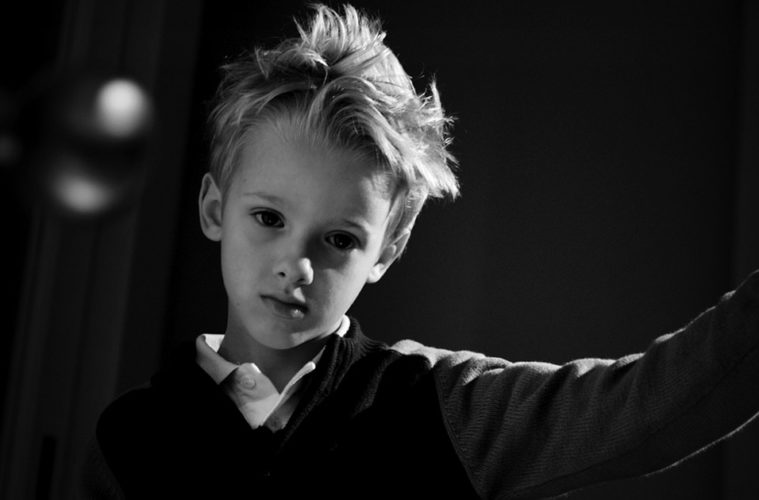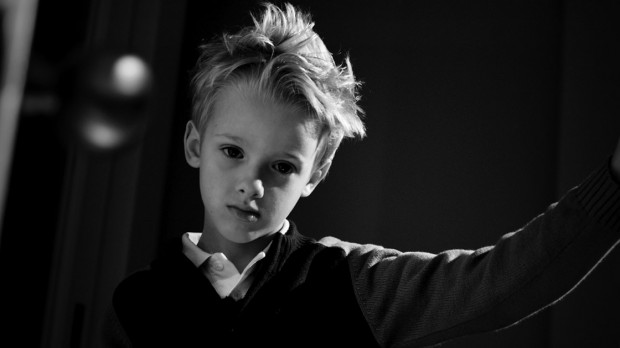
One will likely first hear about Escape From Tomorrow due to writer-director Randy Moore shooting the film on the premises of Disney’s two North American resorts, without their permission. The film had its initial premiere at Sundance — where we noted, “while imperfect in many ways, there is an abundance of cinematic originality to revel in that makes [the film] feel like a dizzying teacup ride into madness” — and rumor had it that Disney was none too pleased, but needless to say, here it is.
The film is currently in limited release around the country (find showtimes here), along with on VOD, and below we have my chat with Moore shortly after the film’s premiere at Fantastic Fest. Among the highlights of my chat with Moore was the fact that he agrees with the criticism of the green screen use and explains what he was actually going for, how they nearly had a disaster from the first day of casting, what parts of the parks he wished could have made the theatrical cut, how different the Sundance cut and the finished version is, and much much more.
The Film Stage: This film was obviously shot under secrecy at Disney, but some have qualms with the use of green screen in a few sequences. As a filmmaker, how frustrated are you by the fact that you had to use green screen at all, and how integral to the plot were those sequences in your mind?
Randy Moore: There were always green screen shots planned, before we even went into the park. There were maybe two or three added after we shot because we weren’t happy with the results we got in the park. If there’s something I wish we could go back and change it is the green screen sequences. Originally I wanted the green screen to be more obvious, actually. I wanted it to resemble a badly processed shot with jump cuts in the background and the perspective being wrong. So it wouldn’t have that effect of, “Oh, that’s just bad green screen.”
Instead it would be more of a stylistic choice. I used post-production in Korea and I kept trying to get across to them that, “No, I don’t want it to look good! I want it to look really, really shitty.” I just couldn’t get that across. I feel like they felt it would hurt their reputation so a lot of the shots that are obvious green screen are just my failing to communicate with them. I don’t want to blame them. It’s my fault for not being more forceful on the issue. I think that’s what you’re talking about with the issues with the green screen and that’s a very fair criticism. I’ll take that.
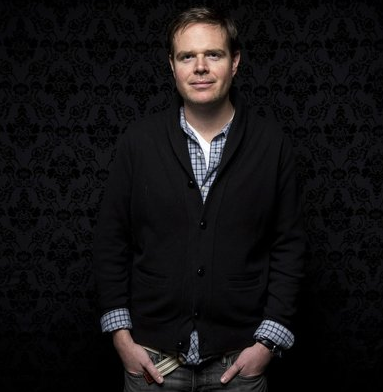 That’s crazy that it just ended up being a lost in translation kind of situation.
That’s crazy that it just ended up being a lost in translation kind of situation.
And that was around year three.
You’ve got to wrap!
[Laughs] You have actors calling non-stop asking for footage for their demo reels and you’ve been putting it off. “No, no, just let us finish the film.” Eventually you’re ready to move on to something else. I wish I could have spent more time on that. I was in Korea for a lot of it, as well. If we had brought it to LA to finish it would have been easier to communicate but that would have brought with it its own set of problems.
You mentioned after the premiere screening here at Fantastic Fest that you had auditions for the film, but they weren’t informed auditions. People didn’t know what they were auditioning for quite yet.
Right, right. Well, I haven’t told anyone this story yet. There was secrecy around what we were doing, for obvious reasons. So I had to prepare sides the night before we started auditions in LA. I went through the scenes we were preparing and I changed any references or obvious things that would tie it back to Disney. And there’s a line where one character goes, “I hate Epcot.” So I changed it to something else and made the PDF and sent it to the casting director and said that those were the sides we needed to use. Somehow it got mixed up on the other end and when it came time to audition and the actors had their sides memorized and the first actress goes, “I hate Epcot.” [I said,] “What!? What the fuck?” Then the next one comes in and says the same thing. And suddenly it’s like, “Is this about Epcot?” and all the questions. I spent a while going through all the sides and this was the first day of casting! I was so upset about that.
But going back to your original question, right away we would inform them what the deal with the movie would be. Obviously they had to make that decision on their own if they would want to go through with it.
I’m curious, though, because people have friends and family that they socialize with. How much of a secret was it? Did you, yourself, tell friends and family that you would be shooting a secret film inside Disney?
Only very, very close friends and family. A lot of my friends told me later, “You just disappeared for two years.” In fact, a friend just told me a few weeks ago that it was weird because I was there and then I wasn’t for two years.
So, you just didn’t inform a lot of people.
Yeah, I tried to keep it under the radar. [Laughs] Which is why when we had that first audition with the wrong sides I was just, ugh.
So, you’ve had this film vetted by lawyers. How much of that discussion occurred before production and how much was after?
That all began after Sundance. I’m not a lawyer. I think it’s ridiculous that if you make a movie nowadays you have to read a bible of the ins and outs of entertainment law and I don’t know of any other art forms where you have to take that into account. So I said that I was going to make it pure and not think about any of that stuff. I told my DP that we were going to shoot it on the Canon 5D. I knew its amazing potential transfers to 35MM stock. That would be my definition of success. Maybe we’ll show at some small festivals and from there probably do some underground screenings. I was never under the idea that we would make a lot of money with this movie or any money — that wasn’t the goal.
That’s why when you’re closer and closer to the finish line you start to become paranoid. You’re almost there and that’s when it really starts to become real. We even made out film prints in Korea because I didn’t trust.. I mean, where do you make your film prints in LA? Burbank. So my goal was to literally get it in the can the way I wanted to. It could have played underground forever. I never, ever expected to get into Sundance. I didn’t even think about festivals while I was making it. One of my actors said something about it and I was literally like, “All we’re thinking about is this movie. Don’t talk to me about film festivals right now.” So when we turned in the Sundance submission I burned a DVD on my laptop and put it in a paper case and threw it in the mail. Then one night I was driving with my wife and I got a call. It was Trevor Groth, the head programmer at Sundance, and he said congratulations.
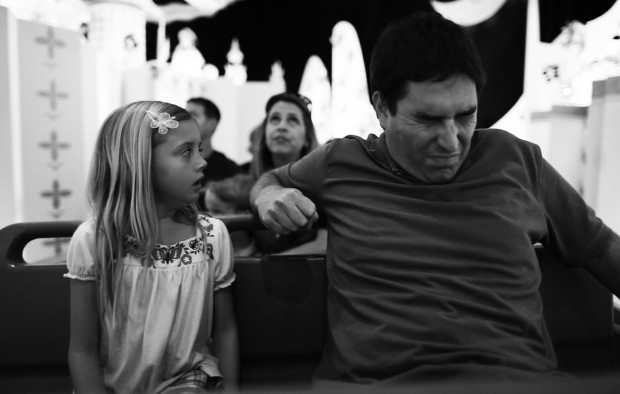
And it all snowballed from there. I’m curious, Was this at any point called “Escape From Tomorrowland”?
No!
But it seems like you’ve heard that before?
Yeah. You’re the second person to ask me that. When we were at Sundance, right after the premiere, the next day Pixar announced this movie with Brad Bird and George Clooney collaborating. They announced this film that they were making called Tomorrowland. And people started suggesting we should call it “Escape From Tomorrowland” and stuff. But, no. Originally, it was called “Escape From Epcot” but we thought that might give a little too much away. [Laughs] We just wanted to get that first Sundance screening in. We weren’t sure we were going to have a second one. But once we started in pre-production and sending out casting notices we decided we needed an alternate title so it wasn’t totally obvious. Escape From Tomorrow was originally our working title and then I got used to it and how it played into the whole mythology around the movie and then I really liked it.
You filmed at both parks?
Yeah. We flew to both coasts. But most of us are LA-based so that was easier to go to. But I grew up with Disney World. That’s the one I went to with my father. The castle is bigger. It’s Disneyland on steroids. You get a different crowd there; it’s more of a slice of Americana. And it’s a little stranger because it really is a world there. Cinematically it’s much wider and huge vistas. It’s not surrounded by Howard Johnson’s Ramada Inns. And of course it’s got Epcot. And I don’t know why I’ve always had this strange fascination with that. So I really wanted to showcase that park and everything we could do after, in Anaheim. We were there eleven times with the cast and crew and then went back tons of times with just a camera to get pickup shots.
So, I’ve got to ask why there wasn’t anything in The Haunted Mansion.
Well, there was a scene in The Haunted Mansion but it didn’t make it into the final cut. In that scene we actually rebuilt the parlor room where the person hangs themselves.
And were there more places besides The Haunted Mansion that didn’t make it into the cut?
There were a ton. It could have been easily a six-hour movie. We shot nearly every ride. We shot Pirates of the Caribbean, we shot Jungle Cruise… which is actually one of the most beautifully shot rides did. The cinematography in that is amazing. We did a lot of informal test screenings with friends and family. The rides are awesome when you’re on them, but when you’re just watching them, they’re not quite so interesting. [laughs]
It doesn’t translate.
Yeah. And they look cheesy. So less rides was one of our first big editorial decisions, because we could have just had them on rides all day long.
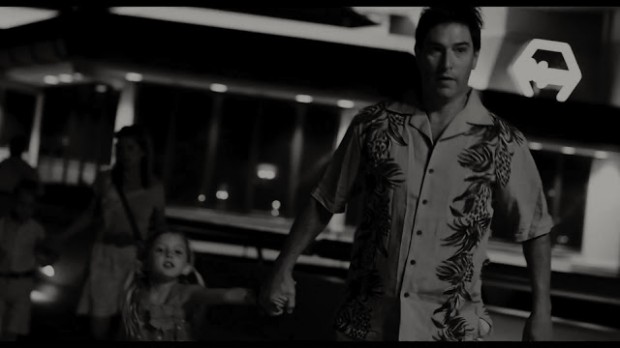
From what I understand there have been different cuts of this film?
Just the Sundance cut and this cut.
What were the differences?
By the time it premiered at Sundance, the picture had been locked almost a year. For budgetary reasons we were having our effects coming in from Korea; we had sound design working on it, and as a first time director I was nervous to reopen it. There is a lot of headaches when you reopen a film once it’s locked. So I was reluctant. But by the time it played at Sundance I had been watching the same cut for a year. So obviously I had a huge list of notes that if I could have changed I would have. Then after Sundance our sales agent from Cinetic started talking with me and attorneys and we wanted to add a disclaimer to the beginning and clarify a few minor things in terms of content.
So, 95 percent of the stuff we did to that cut was all editorial: trimming it down, streamlining it, making it shorter, cutting the heads and tails of scenes of people walking in and out — stuff I had been dreaming of doing but didn’t have the wherewithal to do until I got that opportunity. So we cut 14 minutes, which sounds like a lot but it was all fat, basically. There was no major sequences cut at all and in fact we added some sequences that wasn’t in the original Sundance cut. The only thing we really cut was an intermission montage that was reminiscent of the beginning of Superman 2. It just caught you up to speed with this epic montage and cast Jim as this Odysseus character (which, in his mind, he was). If there’s ever a director’s cut, that’s the one thing that I’d put back.
I was going to ask about special features. Have you had any talks about DVD extras? One thing I’m sure a ton of people would be interested in would be how this film was shot.
God, I wish that we had a second crew following us doing this film. I think maybe the idea crossed my mind for a second, but it was just so nerve wracking even having one crew that there was no way we could have done that. And no, we haven’t talked about anything beyond VOD and theatrical release right now.
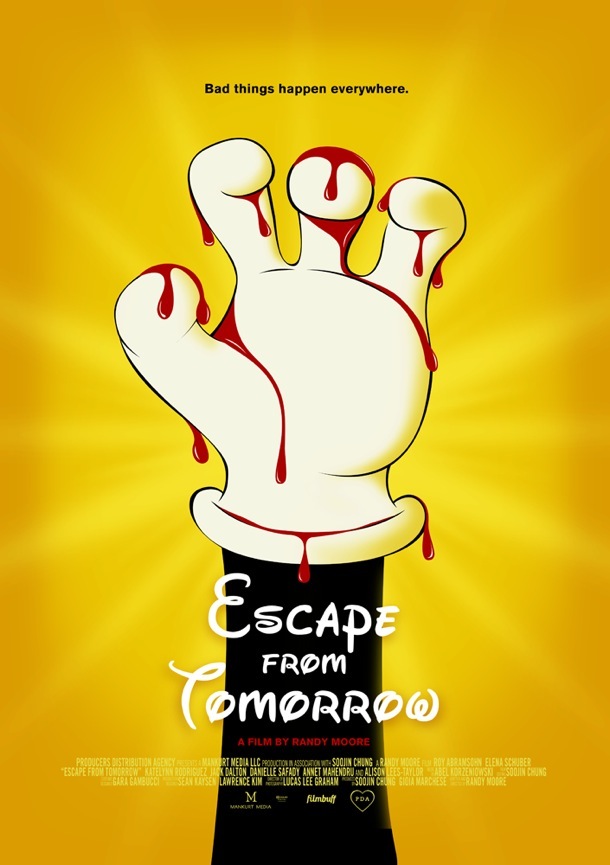
Escape From Tomorrow is now on VOD and in theaters.

